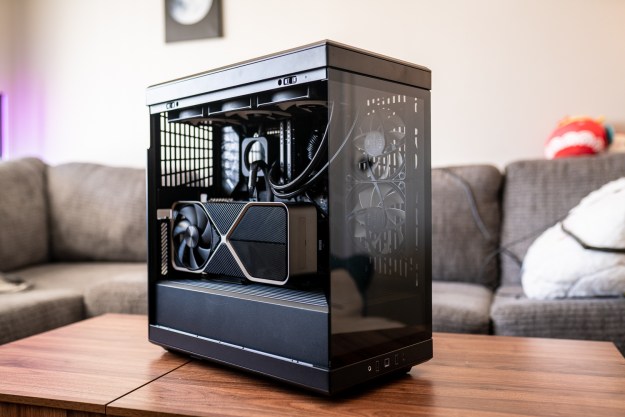Fanless PC builds aren’t anything new, but YouTuber Matt Perks from the DIY Perks channel decided to take the concept a step further. The result is a massive fanless PC chassis that “breathes” to keep itself cool. And even with DIY sensibilities intact, the case works surprisingly well.
In an 18-minute video (above), DIY Perks details the trials that went into creating such a unique design. The case is comprised of two chambers, one housing the “lungs” and the other holding the components. Using opposing magnets and cheap water pumps, the bottom portion moves sheets of acrylic back and forth automatically. As the sheets move, they push out warm air and draw in cool air, just like a PC fan would.
However, this design alone wouldn’t keep the components cool. As the video explains, pushing out hot air would simultaneously draw back in the hot air that was pushed out on the opposing side, effectively canceling the cooling potential. To get around this issue, the top chamber has a series of vents that open when air is being drawn in before sealing.
This forces the air out of the top of the case, which is exactly where it’s supposed to go. Mounted above the top chamber is a massive radiator that handles cooling for the CPU and GPU. The two components are connected through a custom water loop, with the CPU mounting block holding a pump and reservoir.
The build alone is astounding, but the thermal performance is even more impressive. Even with an unproven cooling design, DIY Perks outfitted the rig with a 16-core AMD Ryzen 5950X and Nvidia RTX 3080. As the flagship products from their respective brands, these components are some of the most powerful options on the market. That’s great for a traditional build, but more power brings more heat.

Still, the design held up in thermal tests. In a Prime95 stress test of the CPU, DIY Perks saw the processor hit a maximum temperature of 60 degree Celsius. The graphics card only crept slightly higher to 62 degrees Celsius in a FurMark test.
Although higher than a custom watercooling rig, those are totally usable temperatures. A big reason why is the size and smart airflow design of the case, which allows the components to stay passively cooled without raising the overall temperature inside.
And it’s silent. DIY Perks went as far as to include a passive power supply to keep fans completely out of the system. Outside of a small amount of noise from the acrylic plates and some light flapping from the air valves, the machine produces almost no noise.
The design is beyond anything we’ve ever seen before. Although we hit the highlights here, we highly recommend watching the full video to see what went into this build. At one stage in the process, Perks even went through the process of plating a magnet with nickel to get everything to work.
Editors' Recommendations
- As a lifelong PC gamer, these are the apps I couldn’t live without
- Air cooling vs. liquid cooling: Which is best for your PC in 2024?
- PC ports need to be better in 2024 — here’s how
- As a pro PC builder, here are 5 building tips no one tells you
- Here’s how you can win this insane, custom Starfield PC




